#Alberta history
Text
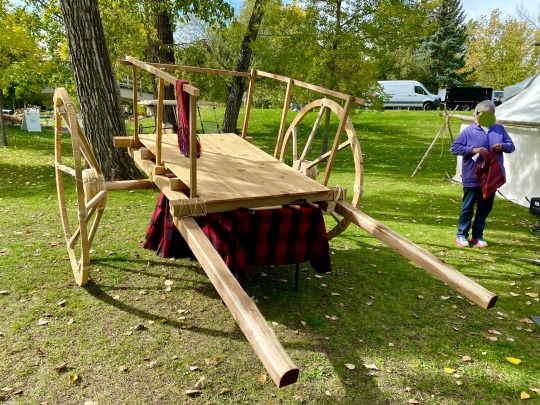

françoise (red river cart), 2023
My second red river cart built for the city of Calgary's parks educational programming about local Métis Otipemisiwak history. The cart is propped up for stability while it is not in use and because there was a last minute problem with a spoke that I will be repairing so that the cart will be able to function for years to come! It accomanies a Métis Otipemisiwak trappers tent and several large vinyl panels of archival material for education. I also delivered the following speech after Elder D. D. spoke some beautiful words and M. H. introduced me and fellow artist D. P. who created beaded and illustrated borders in the style of historic Michif beadwork for the selected archival images.
Taanishii kiiyawow? riel s. dishinikashoon. Hello, how are you all? my name is riel s. and i descend maternally from seven Métis Otipemisiwak families from the historic Red River Settlement and Batoche. Notably my Berthelet ancestors were community leaders in Pointe à Grouette, now Ste. Agathe, MB. Throughout this project I thought often of my 5th great uncle Jean Caron Sr. who fought in the North-West Resistance of 1885 in which his house was burnt down. It was later rebuilt in 1891 and it still stands in Batoche to this day. I introduce myself in this way, the traditional way of the Métis Otipemisiwak to contextualize my knowledge and experiences, situate myself on this land, and honour my family.
The red river cart is a symbol of Michif (Métis Otipemisiwak) ingenuity and survivance. From the land it rises and to the earth it will decompose again, not leaving a trace, not a nail or a screw. I built my first cart in 2022 during my undergrad as I considered histories of road allowance, trade, and Michif material culture's place in contemporary art. It is the vessel that carried us across our vast homelands and beyond, and cradled our young nation, serving us in our fight for sovereignty, dignity, and respect.
I would like to thank my friend C. for their assistance in parts of the building process, as well as their trust, friendship, and curiosity. I would also like to thank M. H. and D. P. for this opportunity and your guidance as mentors and your friendship. Maarsii.
#Métis/Otipemisiwak/Michif all refer to the same people lol#srry it's confusing#Metis Otipemisiwak is the legal name#michif is another name and the name of our language#my work#artwork#archive#archival work#historical interpretation#Métis#michif#history#alberta history#indigenous#fnmi#indigenous history#first nations#canada#canadian history#canadian art#contemporary art#traditional art#woodworking#western#western art#fur trade#my writing#poetry#artist#art
45 notes
·
View notes
Text
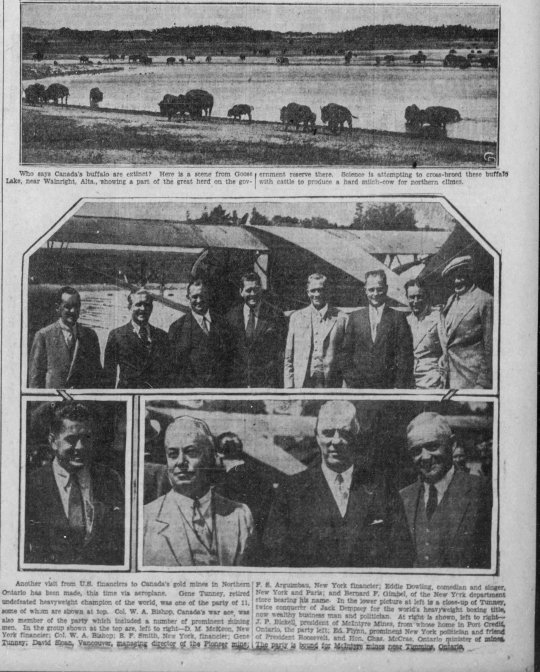
"Who says Canada's buffalo are extinct? Here is a scene from Goose Lake, near Wainright, Alta, showing a part of the great herd on the government reserve there. Science is attempting to cross-breed these buffalo with cattle to produce a hard milch-cow for northern climes.
////
Another visit from US financiers to Canada's gold mines in Northern Ontario has been made, this time vis aeroplane. Gene Tunney, retired undefeated heavyweight champion of the world, was one of the party of 11, some of whom are shown at top. Col. W. A. Bishop, Canada's war ace, was also member of the party which included a number of prominent shining men. In the group shown at the top are, left to right - D. M. McKeon, New York financier; Col. W. A. Bishop; B. F. Smith, New York, financier; Gene Tunney, David Sloan, Vancouver, managing director of the Plonser mine, P. S. Arguimbau, New York financier; Eddle Dowling, comedian and singer, New York and Paris: and Heard P. Gimpel, of the New York department store bearing his name. In the lower picture at left is a close-up of Tunney, twice conqueror of Jack Dempsy for the world's heavyweight boxing title, now wealthy business man and politician. At right is shown, left to right - J. P. Bickell, president of McIntyre Mines, from whose home in Port Credit, Ontario, the party left; Ed Flynn, prominent New York politician and friend of President Roosevelt, and Hon. Chas. McCrae, Ontario minister of mines. The party bound for McIntyre mines near Timmins, Ontario."
- from the Kingston Whig-Standard. June 26, 1933. Page 10.
#northern ontario#timmins#mining company#financial capitalism#stock promoter#financiers#famous athlete#billy bishop#capitalism in canada#gold rush#resource capitalism#great depression in canada#northwestern ontario#resource extraction#vancouver#port credit#bison#the passing of the buffalo#alberta history
24 notes
·
View notes
Text
We don't talk about how hard Matt goes for Halloween. Modern Halloween as we know it is very much a Canadian creation. The term "trick or treat" was 'invented' in Alberta.
Just Matt going all out for Halloween
5 notes
·
View notes
Text
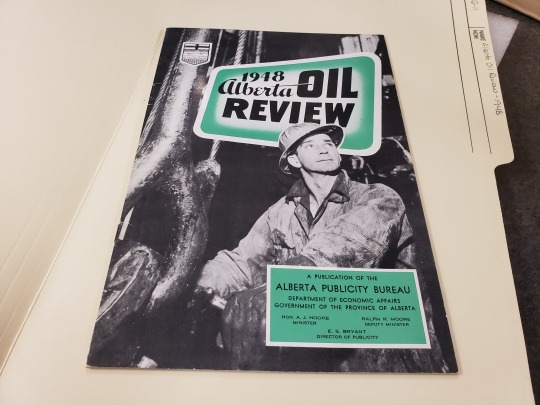


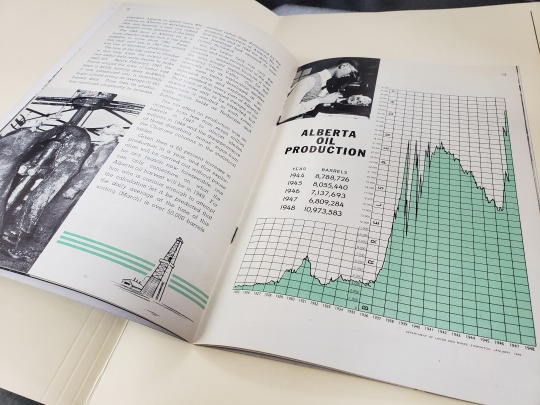
1948 Alberta Oil Review
A Publication of the Alberta Publicity Bureau
It's a quiet Saturday at the museum front desk, so I'm using the time to look through some of our collection's old publications, compiling information I can incorporate into the new exhibit.
This lovely little booklet beautifully lays out the state of oil production in Alberta for 1948. Am I partial to it because of its use of turquoise? Maybe. But beyond that it's a great snap-shot of the impact the Leduc oilfields had on the industry less than 2-years in. And it has graphs. I love graphs.
#Canadian Energy Museum#CEM#Museum#Alberta#Leduc#Alberta History#History#Oil Industry#1940s#20th Century#Post-WWII#Mid-20th Century#Mid Century#turquoise#Social History#Local History#Edmonton#Devon#Devon AB#Publication#Research#Exhibit#Exhibition#Exhibit Planning#museology
2 notes
·
View notes
Photo
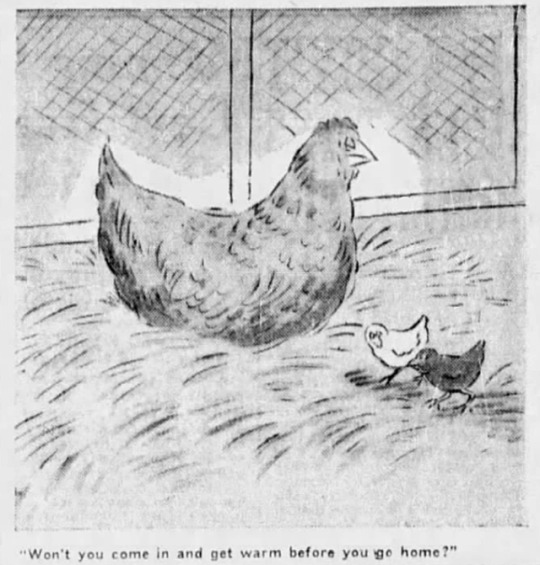
Calgary Herald, Alberta, March 3, 1936
1K notes
·
View notes
Text
The University of Alberta is offering a new free online course to highlight the history and accomplishments of Black Canadians.
Called Black Canadians: History, Presence, and Anti-Racist Futures,the course will explore topics like systemic racism and unconscious racial bias in Canadian institutions.
The course became available Friday.
Course director Andy Knight, a political scientist at the U of A and provost fellow in Black excellence and leadership, spoke with Radio Active host Jessica Ng about the four-module course. [...]
Continue Reading for interview.
Tagging: @politicsofcanada, @vague-humanoid
2K notes
·
View notes
Text
Heart Creek Bunker | Alberta Hikes
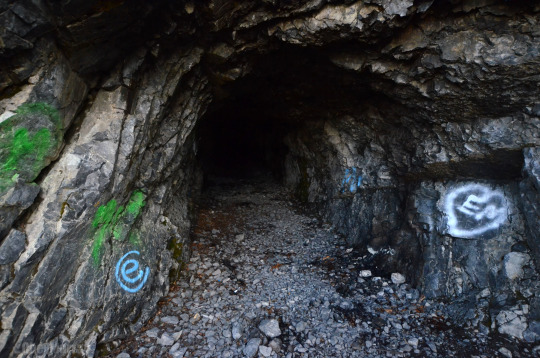
Hike Type: Easy, Busy
Location: Bow Valley Provincial Park, Alberta, Canada
Notes: Bring bear spray and a flashlight.
Within Alberta is a man-made cave known as "Heart Creek Bunker." According to local lore, it was intended to be a nuclear shelter, but was never completed. That is mostly the truth. It was dug out by two brothers, Joe and Stan Rokosh, who had dreams of turning it into a storage facility. While they do mention the possibility of use for disasters, their main goal was storage.
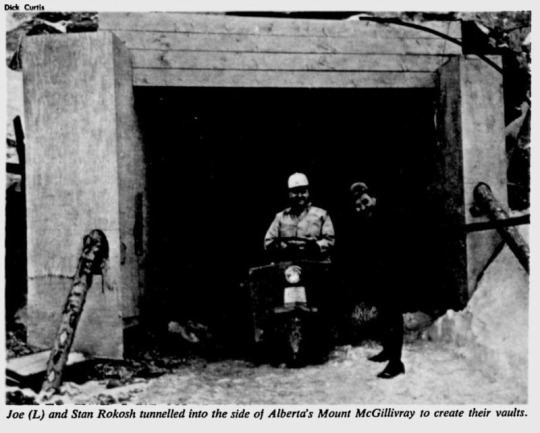

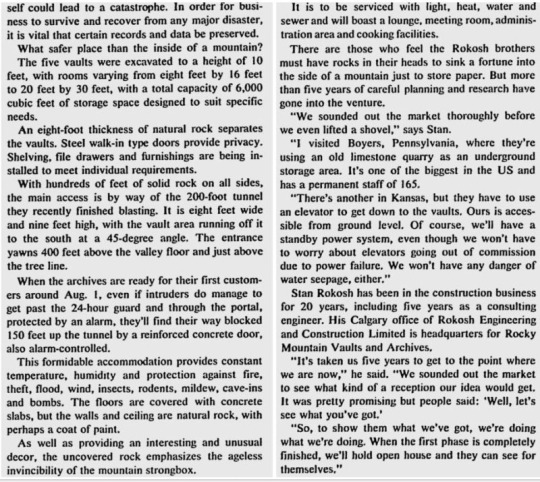
To get there, I first parked at Heart Creek day-use area, and followed the Trans-Canada trail. It has been many years since I was last there (2015), and much of the trail was washed out by flooding, but keeping left on the trails was all it took to reach the cave.
The Caves themselves are shallower than you might expect, with two dead-ends, and the walls were littered with spray-paint and used candles.
If you decide to go yourself, do note that I did spot a bear print, so be sure to bring bear-spray. Also, don’t forget a flashlight!
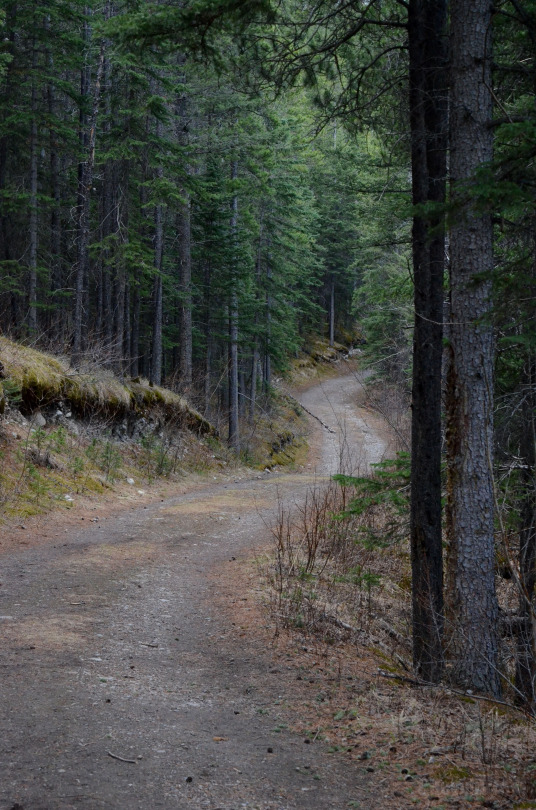
#alberta#albertahike#albertahikes#albertahiking#alberta history#hikes#hiking#outdoors#canada#TravelAlberta
0 notes
Text
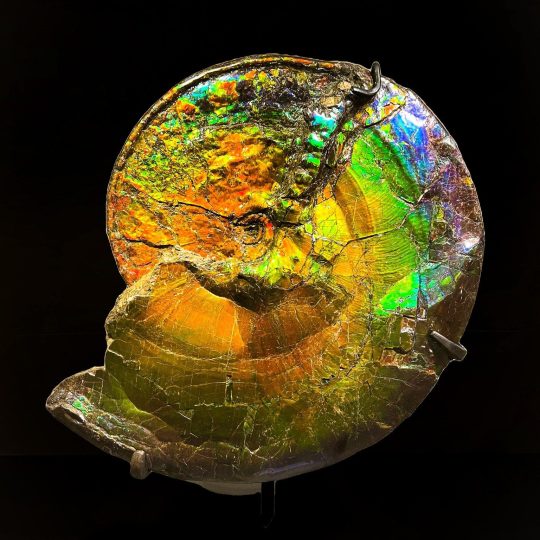
Behold the dazzling colors of an iridescent ammonite (Placenticeras intercalare)! A relative of today’s squids, this ammonite lived some 80 million years ago near what is now Alberta, Canada. This fossil’s spectacular coloration is the result of millions of years of high temperatures and pressures. As these forces acted on nacre in this ammonite’s shell, it was transformed into a gemstone known as an ammolite. Along with amber and pearl, ammolite is one of only a handful of gems made by living organisms. You can spot this rare specimen in the Louis V. Gerstner, Jr. Collections Core in the Museum’s Richard Gilder Center for Science, Education, and Innovation!
Photo: © AMNH
#amnh#museum#science#nature#fossil#natural history#animals#paleontology#ammonite#ammolite#did you know#fact of the day#rainbow#cool animals#alberta#pride#iridescent#cephalopods#squid#ancient animals
556 notes
·
View notes
Text

Art students painting hoodoos.
Banff National Park, Alberta
1957
#vintage camping#campfire light#alberta#canada#banff national park#nature painting#NFB#history#hiking#travel#1950s
517 notes
·
View notes
Text
111 notes
·
View notes
Text




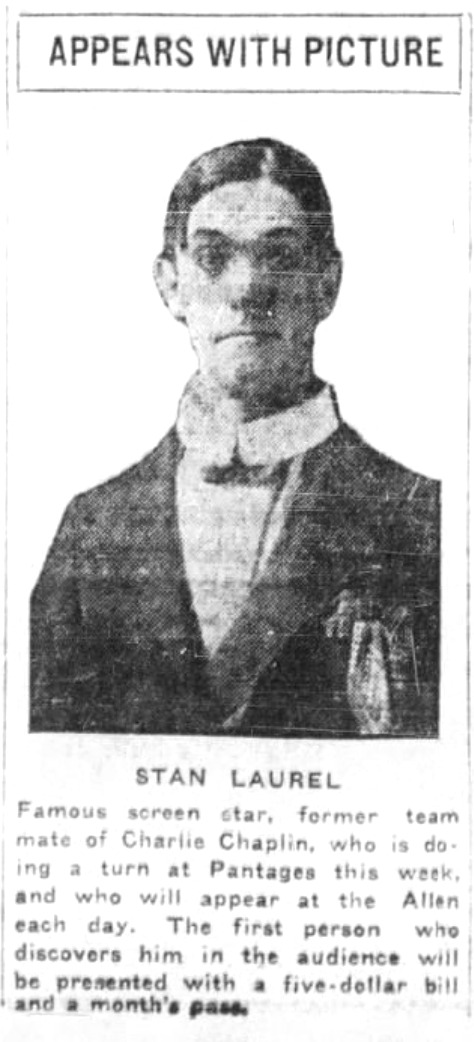




1919.
Stan Laurel in Calgary, Alberta.
82 notes
·
View notes
Text

In honour of #BlackHistoryMonth, we wanted to share the story of John Ware, one of many Black individuals who have helped shape Alberta and Canada’s heritage and identity.
Born into slavery on a South Carolina plantation around 1845, he rose to fame on the prairies because of his exceptional horsemanship skills. Ware purchased a ranch near Millarville in 1891 and the next year he married Mildred Lewis. The couple had six children.
As more people moved into the Millarville area, the family relocated along the Red Deer River, north of Brooks Alberta, near what is now Dinosaur Provincial Park.
Read more on his legend and how to visit his cabin this summer: https://bit.ly/42kVCAw
#dinosaur provincial park#brooks Alberta#alberta#canada#John Ware#black history month#black history#1845#circa 1891#circa 1845
146 notes
·
View notes
Text

"FAMILY CONTINUES HUNT FOR DINOSAUR," Sault Star. May 8, 1934. Page 12.
----
Sternberg Father and Sons Comb Hinterlands For Animal Bones
----
(By Guy E. Rhoades, Canadian Press Staff Writer)
Toronto, May 8. - (C. P.) - If Levi Sternberg goes to the field this year, and he hopes he will, it will be his 14th expedition as a dinosaur hunter in 16 years, but that, he says, is nothing compared with the record of his father and two brothers.
Levi, preparator of paleontology at the Royal Ontario Museum, is the youngest member of a dinosaur-hunting family that has gained the plaudits of scientists for almost six decades. His father, C. H. Sternberg, made his first expedition to the Kaлsas fossil beds in 1876 with the late Edward Drinker Cope, professor of geology at the University of Pennsylvania and one of the most noted pal- eontologists of the last century.
The old man, now 84, is still working on the Pacific Coast, making his headquarters at San Diego, Cal., Levi has been working for the Oftario museum since 1919. Charles has been with the National Museum in Ottawa since 1912 and George is now at Kansas Teachers College in Hays.
Sternberg senior started collecting fossils in Kansas when he was 17, at a time when many people did not know the strange rocks with patterns in them were remains of plants and animals that lived millions of years ago. He did little work in museums, but he was recognized as one of the greatest fossil hunters and is now the veteran of them all.
He and all his sons worked for the National Museum before the war, searching the badlands of Alberta for the petrified bones of monsters that roamed that weather-scarred, barren country when the land was a steaming swamp covered with tropical vegetation.
The father and George returned to the United States, but Charles and Levi remained in Canada and continued to make trips to Alberta, usually along the Red Deer Valley, bringing back their specimens in the fall and spending the winter mounting them for exhibition in the halls of their museums.
#levi sternberg#sternberg family#royal ontario museum#dinosaur hunters#fossil collectors#paleontology#early 20th century paleontology#great depression in canada#alberta badlands#alberta history#toronto
4 notes
·
View notes
Photo

Sergeant of the Royal Engineers Signals Section putting a message into the cylinder attached to the collar of a messenger dog at Etaples, 28 August 1918.
#ww1#world war 1#The First World War#history#historical photos#war history#battlefield#british army#wwi#The Great War#1918#1917#1916#Veterans#remembrance day#alberta canada#canada#1914#france#belgium
333 notes
·
View notes
Text

First tyrannosaur fossil discovered with its last meal perfectly preserved in its stomach
Researchers have found a tyrannosaur’s last meal perfectly preserved inside its stomach cavity.
What was on the menu 75 million years ago? The hind legs of two baby dinosaurs, according to new research on the fossil published Friday in the journal Science Advances.
Dinosaur guts and hard evidence of their diets are rarely preserved in the fossil record, and it is the first time the stomach contents of a tyrannosaur have been uncovered.
The revelation makes this discovery particularly exciting, said co-lead author Darla Zelenitsky, a paleontologist and associate professor at the University of Calgary in Alberta.
“Tyrannosaurs are these large predatory species that roamed Alberta, and North America, during the late Cretaceous. These were the iconic apex or top predators that we’ve all seen in movies, books and museums. They walked on two legs (and) had very short arms,” Zelenitsky said.
“It was a cousin of T. rex, which came later in time, 68 to 66 million years ago. T. rex is the biggest of the tyrannosaurs, Gorgosaurus was a little bit smaller, maybe full grown would have been 9, 10 meters (33 feet).”
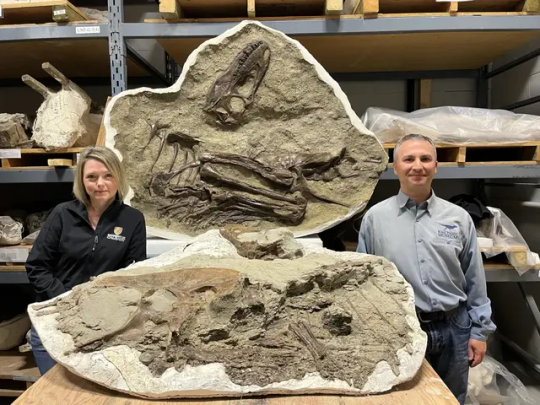
The tyrannosaur in question, a young Gorgosaurus libratus, would have weighed about 772 pounds (350 kilograms) — less than a horse — and reached 13 feet (4 meters) in length at the time of death.
The creature was between the ages of 5 and 7 and appeared to be picky in what it consumed, Zelenitsky said.
“Its last and second-to-last meal were these little birdlike dinosaurs, Citipes, and the tyrannosaur actually only ate the hind limbs of each of these prey items. There’s really no other skeletal remains of these predators within the stomach cavity. It’s just the hind legs.
“It must have killed … both of these Citipes at different times and then ripped off the hind legs and ate those and left the rest of the carcasses,” she added. “Obviously this teenager had an appetite for drumsticks.”

The two baby dinosaurs both belonged to the species called Citipes elegans and would have been younger than 1 year old when the tyrannosaur hunted them down, the researchers determined.
The almost complete skeleton was found in Alberta’s Dinosaur Provincial Park in 2009.
That the tyrannosaur’s stomach contents were preserved wasn’t immediately obvious, but staff at the Royal Tyrrell Museum in Drumheller, Alberta, noticed small protruding bones when preparing the fossil in the lab and removed a rock within its rib cage to take a closer look.
“Lo and behold, the complete hind legs of two baby dinosaurs, both under a year old, were present in its stomach,” said co-lead author François Therrien, the museum’s curator of dinosaur paleoecology, in a statement.
The paleontologists were able to determine the ages of both the predator and its prey by analyzing thin slices sampled from the fossilized bones.
“There’s growth marks like the rings of a tree. And we can essentially tell how old a dinosaur is from looking at those, the structure of the bone,” Zelenitsky said.
Changing appetites of top predators
The fossil is the first hard evidence of a long-suspected dietary pattern among large predatory dinosaurs, said paleoecologist Kat Schroeder, a postdoctoral researcher at Yale University’s department of Earth and planetary science, who wasn’t involved in the research.
The teen tyrannosaur didn’t eat what its parents did. Paleontologists believe its diet would have changed over its life span.
“Large, robust tyrannosaurs like T. rex have bite forces strong enough to hit bone when eating, and so we know they bit into megaherbivores like Triceratops,” Schroeder said via email. “Juvenile tyrannosaurs can’t bite as deep, and therefore don’t leave such feeding traces.”
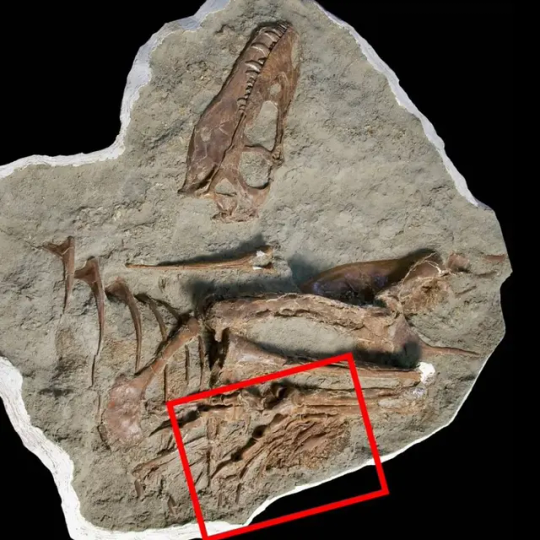
She said that scientists have previously hypothesized that young tyrannosaurs had different diets from fully developed adults, but the fossil find marks the first time researchers have direct evidence.
“Combined with the relative rarity of juvenile tyrannosaur skeletons, this fossil is very significant,” Schroeder added. “Teeth can only tell us so much about the diet of extinct animals, so finding stomach contents is like picking up the proverbial ‘smoking gun.’”
The contents of the tyrannosaur’s stomach cavity revealed that at this stage in life, juveniles were hunting swift, small prey. It was likely because the predator’s body wasn’t yet well-suited for bigger prey, Zelenitsky said.
“It’s well known that tyrannosaurs changed a lot during growth, from slender forms to these robust, bone-crushing dinosaurs, and we know that this change was related to feeding behavior.”
When the dinosaur died, its mass was only 10% of that of an adult Gorgosaurus, she said.
How juvenile tyrannosaurs filled a niche
The voracious appetite of teenage tyrannosaurs and other carnivores has been thought to explain a puzzling feature of dinosaur diversity.
There are relatively few small and midsize dinosaurs in the fossil record, particularly in the Mid- to Late Cretaceous Period — something paleontologists have determined is due to the hunting activities of young tyrannosaurs.
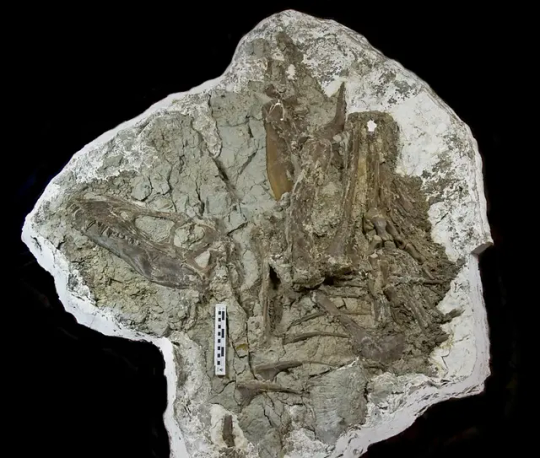
“In Alberta’s Dinosaur Provincial Park, where this specimen is from, we have a very well sampled formation. And so we have a pretty good idea of the ecosystem there. Over 50 species of dinosaurs,” Zelenitsky said.
“We are missing mid-sized … predators from that ecosystem. So yeah, there’s been the hypothesis that, the juvenile tyrannosaurs filled that niche.”
By Katie Hunt.


#First tyrannosaur fossil discovered with its last meal perfectly preserved in its stomach#tyrannosaur#Gorgosaurus libratus#Citipes#Citipes elegans#dinosaurs#paleontologist#Alberta’s Dinosaur Provincial Park#archeology#archeolgst#history#history news#ancient history
77 notes
·
View notes
Text
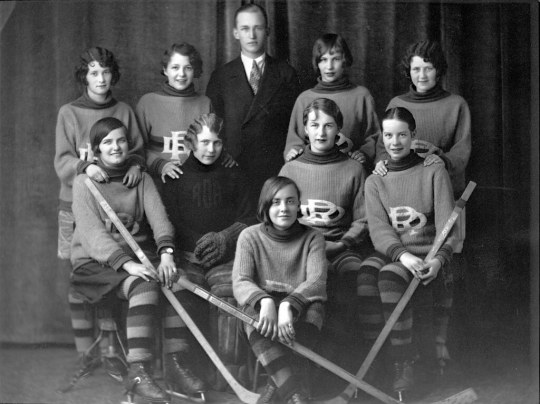
As women began to enjoy a higher status in many societies, they began to look back to the myth of the Amazons for inspiration. Some women’s sports teams called themselves the Amazons. I love this picture of the Red Deer, Alberta Amazons hockey club from 1928.
{WHF} {Ko-Fi} {Medium}
124 notes
·
View notes